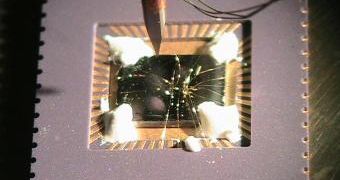A team of scientists in the US developed a new device that can trap large numbers of atoms in a 3-D array, and can then image each one individually. This new method could be very useful in the development of the quantum computer, due to the fact that it can address each atom individually.
The basic principle of quantum computation is that the quantum properties of particles can be used to represent and structure data and that quantum mechanisms can be devised and built to perform operations with these data.
While it's true that each particle carries a single bit of quantum information, or qubits -based on the fact that quantum states can be interpreted as information, which can be compressed in a state and stored on a smaller number of states - it is still extremely hard to trap large numbers of particles and address them individually.
A team of scientists, made up of David Weiss, Karl Nelson and Xiao Li at the Pennsylvania State University, devised a new method of trapping atoms in an optical lattice, which is an interference pattern created when two laser beams meet.
They managed to trap the atoms trapped between the light and dark fringes in the pattern, like ping pong balls in an egg box. "The difference in what we're doing in this apparatus is that we have a large array where we can observe each individual atom," Weiss says.
By using three lasers arranged at right angles, the scientists were able to create a lattice capable of trapping 250 atoms of cesium, which they photographed layer by layer, thus proving that it's possible to see each one.
"If you can't see them, it's much harder to manipulate them individually," Weiss says. But, he adds, because they can make out individual atoms, "it's pretty clear that we should be able to manipulate them independently of each other".
This is extremely good news for the field of quantum computing, which could mean that this futuristic concept will become less fiction and more science, in the not so distant future. The ability to make such applications work under ordinary conditions is a breakthrough in the field.

 14 DAY TRIAL //
14 DAY TRIAL //